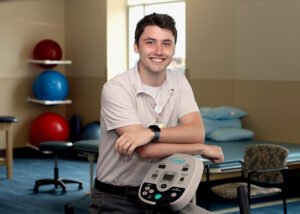Foot care matters more as you age
By Deborah Jeanne Sergeant

If your feet hurt, not much else matters. As you grow older, foot pain tends to worsen. Fortunately, you can reduce foot pain.
Chris Guzzi, doctor of physical therapy at Oswego Health, offered a few tips.
1. Strengthen
“The aging population generally becomes more sedentary as they age, which can lead to joint stiffness and weakness. Inactivity is correlated with loss of mobility and strength, just like the saying, ‘If you don’t use it, you lose it.’
“There are many ways to strengthen the feet without over-stressing the tissue and causing more pain, such as towel scrunches in the seated position to improve the musculature on the plantar aspect of the foot — intrinsic foot muscles. This helps provide the foot with improved arch support and stability surrounding the foot and ankle. Exercises that strengthen the ankle will also redistribute force through the joint and provide improved stability, such as using resistance bands in a seated position to work the ankle in different planes of motion.
“Another less-known principle is the importance of having good core-abdominal strength and good hip strength. Proximal stability promotes distal mobility, meaning your extremities will function better if you have strong central support. Lateral hip strength plays a massive role in how the knees and ankles are positioned and strengthening these muscles can significantly improve the force distribution down the body’s kinematic chain into the ankles-feet.
2. Stretch
“It is the same principle as the one mentioned above concerning disuse. Soft tissue extensibility decreases as we age, so it’s important to stretch to prevent excessive muscle-soft tissue tightness. Stretching also helps the joints to become looser, which also stiffens as we age due to arthritic-degenerative changes and loss of fluid within the joint spaces, in conjunction with a sedentary lifestyle. Gentle calf stretching in a seated or standing position can improve muscle tightness in the calf musculature and joint stiffness in the ankle-foot and help decrease pain over time.
3. Massage
“A good way to self-massage is to place a rolling pin or a soup can on the floor and roll the foot over it gently to massage the tissue and stimulate blood flow to the area to help warm-relax the soft tissue. This is beneficial for pain relief and is generally used as an adjunct to strengthening and stretching activities.
4. Balance training
“Balance is another area that decreases as we age, dramatically impacting the elderly.
Training balance will help improve muscular control surrounding the ankle-foot, knee, hip and core-abdominal musculature. Improving the muscular power and stability surrounding these areas can help decrease pain over time, as the body will function more cohesively. Balance training also has an impact on decreasing falls in the older population. The CDC states, ‘In 2019, 83% percent of hip fracture deaths and 88% of emergency department visits and hospitalizations for hip fractures were caused by falls.’ Balance training can significantly reduce the risk of falling in the elderly population, which can help to decrease morbidity and mortality from injuries acquired from falling.
5. Moderation
“Some movements are better than no movement. Starting slow and gradually increasing activity level is beneficial, but listening to the body is essential. If symptoms and soreness last more than a few days after activity, it likely indicates the activity is too much for the body to handle. Resting and taking breaks are OK. Too much activity can worsen pain, but too much rest will only worsen the issues, causing the pain to worsen.
It’s all about finding balance with rest and activity.”

